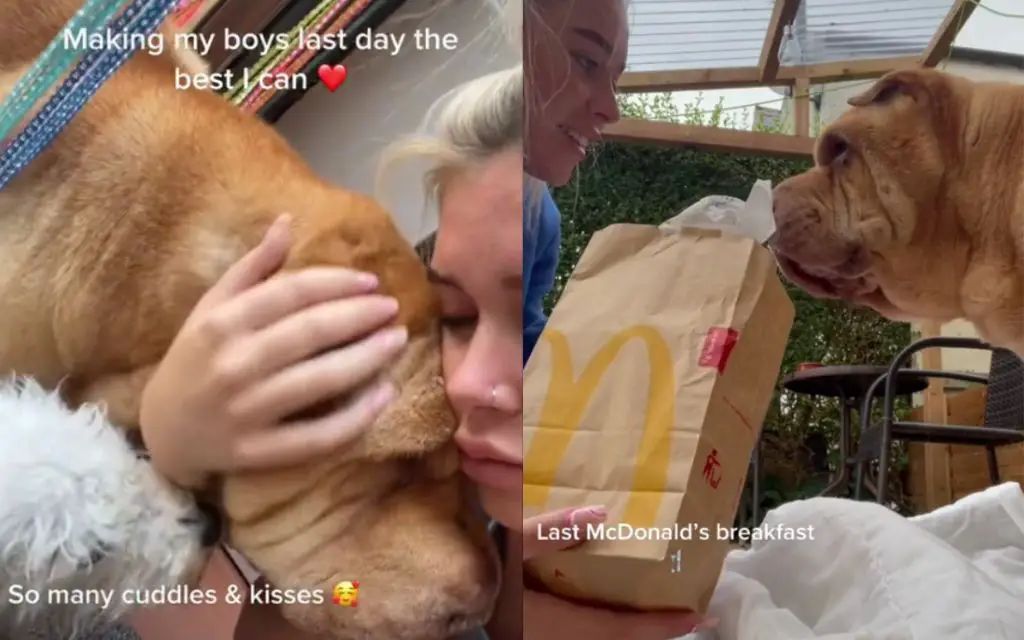Understanding Your Dog’s Health
When your dog is nearing the end of life, having a clear understanding of your pup’s health condition is important. Discussing your dog’s symptoms, diagnosis, and prognosis with your veterinarian can provide valuable insight. Ask your vet to explain your dog’s disease progression and what you can expect going forward. Inquire about any possible treatment options and palliative care to manage your dog’s comfort.
It’s heartbreaking to see your canine companion suffer as their health declines. While euthanasia may eventually need to be considered, first focus on understanding your dog’s condition, remaining hopeful, and making the most of the time you have left together. With your vet’s guidance, you can provide your dog with loving care in their final days. Stay attuned to your pup’s quality of life and allow that to inform decisions about when palliative care is no longer enough. Your vet can advise you on the most peaceful, gentle option when your dog’s suffering can no longer be managed.
Managing Pain
One of the most important things you can do for your dog in their final days is to ensure they are as comfortable as possible. Work closely with your veterinarian to provide medications or alternative therapies that will help maximize your dog’s comfort and quality of life. Some options to discuss with your vet include:

- Prescription medications – Your vet may prescribe medications like steroids, anti-inflammatories, or mild sedatives to help reduce pain and anxiety.
- Natural supplements – There are various dietary supplements thought to aid pain relief, such as omega-3 fatty acids, turmeric, and glucosamine. Always consult your vet before starting any new supplement.
- Acupuncture or physical therapy – Gentle acupressure, massage, or assisted range of motion exercises may bring some relief and comfort.
- Adequate bedding – Providing thick, soft bedding and keeping your dog warm can aid comfort.
Stay attuned to any signs of discomfort in your dog’s body language or behaviors. Bring up any concerns immediately with your veterinarian and be vigilant about pain management in their final days. With attentive care and the right mix of treatments, you can help ensure your beloved dog’s last chapter is as peaceful and comfortable as possible.
Meeting Nutritional Needs
As your dog ages, their nutritional needs may change. It’s important to monitor your dog’s appetite and adjust their diet accordingly. Some tips for meeting your senior dog’s nutritional needs:

- Switch to a senior or weight management dog food formula, which is lower in calories and optimized for a senior dog’s needs.
- Try adding warm water, low-sodium broth, or wet food to dry kibble to increase palatability.
- Hand feed small portions of food frequently throughout the day.
- Avoid rich human foods and stick to high quality commercial dog food recommended by your vet.
- Ask your vet about supplements if your dog is getting thin or losing muscle mass.
Make adjustments to diet to tempt appetite and provide nutrition tailored to your senior dog’s needs. Proper nutrition can help manage age-related issues and keep your dog’s immune system strong.
Providing Tender Loving Care
As your dog nears the end of their life journey, providing tender loving care can help make them as comfortable as possible. Extra love, attention, and companionship during this time are invaluable. Try sitting with your dog and gently petting or massaging them if they enjoy touch. Help your dog remain mobile by assisting them with walks, supporting their body, or using slings if needed. Maintaining familiar routines like feedings, play time, and nap time can also be comforting. Speak softly, stroke their fur, look into their eyes, and savor your final days together. Showing your dog love through tender care helps convey that they are safe, loved, and never alone.

Monitoring for Changes
As your dog ages or deals with health issues, it’s important to carefully monitor their condition on a daily basis. Track any symptoms they are exhibiting and watch for any changes, both positive and negative. Are they eating and drinking normally? Do they seem more sluggish or restless today? Are they having any new issues with pain, mobility, or bathroom habits?
Make notes each day about your dog’s status. That way, you have a clear record you can refer back to in order to identify when and how things have changed. If your dog seems to be declining, don’t hesitate to call your vet right away. They may be able to adjust medications or treatments to help manage symptoms.
It’s also crucial to know when your dog’s quality of life is significantly deteriorating and the time for euthanasia may be approaching. Your vet can guide you on assessing factors like your dog’s comfort level, interest in food or previous activities, and any signs of suffering. Focus on prioritizing their wellbeing and dignity. With attentive daily care and monitoring, you can support their needs until it is truly time to say goodbye.
Planning Ahead
It’s important to make decisions about your dog’s end-of-life care ahead of time and prepare for their eventual passing. This includes deciding whether you want to pursue euthanasia at home, at the vet’s office, or use hospice/palliative care services. Outline your wishes for your dog’s final days and moments in a document or tell loved ones. Doing so provides clarity on how to proceed when the time comes.
Also prepare emergency protocols in case your dog experiences a medical crisis. Know which vet to call or animal ER to visit if your dog needs urgent care. Have their medical history available too. This helps ensure your dog gets the care they need even when hard decisions must be made quickly.
Financially plan for end-of-life expenses like euthanasia services, cremation/burial, mementos, etc. And make arrangements for what will happen after your dog passes – this can bring some comfort when the time comes.
While planning ahead for your dog’s passing is difficult emotionally, it ultimately brings peace of mind. You’ll know how to handle your dog’s final days and how to honor them after they’re gone. This thoughtful preparation helps you fully focus on appreciating your final moments together.
In-Home Euthanasia
When a beloved canine companion reaches the end stages of an incurable disease, many pet owners want their dog’s final moments to be peaceful, pain-free and at home surrounded by family. While euthanizing a pet is always difficult, your veterinarian can provide compassionate in-home euthanasia services to help your dog pass away gently in familiar surroundings.
In-home pet euthanasia involves a vet coming to your house to humanely put your dog to sleep. They will give an injection of an overdose of an anesthetic drug, stopping your dog’s breathing and cardiac function. This is usually a quick and painless process. Your vet will confirm passing before taking your pet’s body to their clinic for aftercare services.
Discuss in-home euthanasia with your vet when planning end-of-life care. They can walk you through the process, costs and what to expect. Many vets provide this service to help grieving pet owners find closure during an emotional time. With your vet’s support, you can be sure your beloved companion’s final moments are peaceful and dignified.
Saying Goodbye
When the time comes to say goodbye to your beloved dog, the most important thing is to make their passing as calm and loving as possible. Focus on providing comfort, not just in their final moments but in the days and weeks leading up to it. Spend extra time snuggling, go for gentle walks, provide favorite foods, and give lots of affection. This will help assure your dog feels safe, loved, and comfortable up to the end.

Invite family members to say their goodbyes in person if possible or with cards and letters if they can’t be there. Consider allowing for a visit from their favorite human companion for devoted petsitter or neighbors. Gather photos and mementos to create a memorial for your dog. Most importantly, take time with them yourself, holding them gently and speaking softly, thanking them for the joy they brought to your life.
Honoring Your Dog’s Life
Losing a beloved dog is incredibly hard. After so many years together, saying goodbye can feel unbearable. While nothing can fill the void left behind, memorializing your dog’s life can provide some comfort during the grieving process. There are many meaningful ways to pay tribute to your cherished companion.
Holding a memorial service, even a small gathering of family and close friends, can provide closure after losing your dog. This gives you a formal chance to share favorite memories, look at photos, and process emotions. You may want to scatter your dog’s ashes at a favorite park or bury them in your yard alongside a memorial marker. Other ideas include planting a tree, creating a memory book or online tribute, or making a donation in your dog’s name to an animal charity.
Finding creative ways to memorialize your pet can be very therapeutic. Some options include framing your dog’s collar or tags, making clay paw print impressions, or commissioning a custom portrait painting of your dog. Display favorite photos and other mementos around your home to keep your dog’s spirit close. Share stories and pictures with others who knew and loved your dog.
The grieving process takes time, so be gentle with yourself. Take things one day at a time and lean on your support system. Keeping your dog’s memories alive through a heartfelt tribute will help you find comfort and eventually make peace.
Coping With Loss
Saying goodbye to your beloved dog is one of the hardest things you’ll ever have to do. The grief and sense of loss can feel overwhelming in the days and weeks after your dog passes away. It’s important to give yourself time and space to grieve. Don’t feel like you need to “get over it” right away.
The grieving process is different for everyone. You may cycle through various emotions like sadness, anger, guilt, loneliness, and regret. This is all normal. Allow yourself to fully feel and process these emotions. Cry when you need to. Talk to friends when you’re ready. Look at photos and reminisce about your happy memories together.
While grieving, also make sure to practice self-care. Get enough sleep, eat healthy meals, and stay hydrated. Take walks outside and get fresh air. Engage in activities you enjoy. Spend time with supportive loved ones. Be patient and kind with yourself during this difficult transition.
If your grief feels debilitating or extremely prolonged, don’t hesitate to seek professional support like counseling or a pet loss support group. They can help you navigate the grieving process in a healthy way, so that over time, fond memories of your dog bring more smiles than tears.